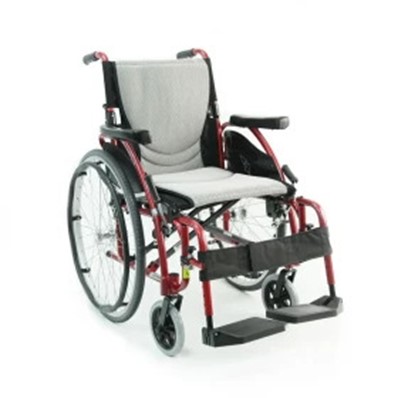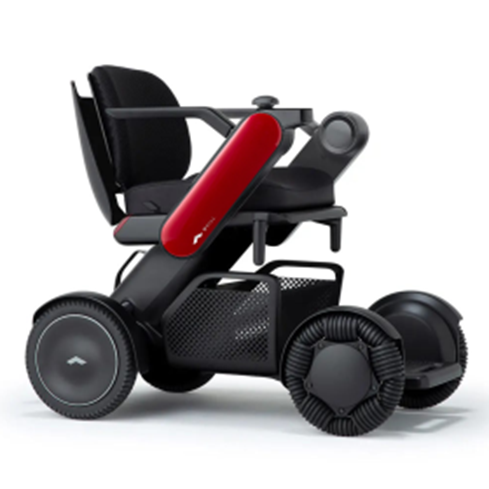For people suffering from a lack of mobility, a wheelchair has been an essential part of individual life for more than a decade. For those individuals wheelchair means independence and freedom, allowing them to navigate their surroundings. However, you can’t just select any wheelchair as it will have a huge impact on your life so choosing the right type of wheelchair makes it crucial to pick the right one. There are two primary options power wheelchair and manual wheelchair.
Power wheelchairs, also known as electric wheelchairs, have revolutionized the way people with mobility challenges navigate the world. These advanced wheelchairs are equipped with an electric motor and battery system, enabling users to move effortlessly and cover long distances without relying on physical strength. On the other hand, a manual wheelchair is also known as a traditional and more conventional choice, it requires the user to self-propel using his strength or rely on the assistance of an outside force such as a caregiver.
In this blog post, Cura360 will delve into the debate between power wheelchairs and manual wheelchairs, comparing their advantages, disadvantages, and unique features. We will explore various factors that individuals should consider when making this important decision, including personal preferences, physical capabilities, lifestyle, and the environment in which the wheelchair will be used. By examining the pros and cons of both types of wheelchairs, we aim to provide you with the information necessary to make an informed choice that best suits your needs and enhances your mobility.
Power Wheelchairs
Pros of Power Wheelchair
- Increased Mobility: The primary benefit of a power wheelchair is the ability to move independently. It grants users the freedom to navigate various environments, such as homes, stores, and outdoor spaces, without relying on assistance from others.
- Enhanced Accessibility: Power wheelchairs offer accessibility features, including adjustable seating positions, elevation capabilities, and specialized controls, allowing users to reach higher shelves, interact with others at eye level, and participate in various activities.
- Reduced Physical Strain: Operating a manual wheelchair requires significant upper body strength and endurance, which can be challenging for individuals with limited mobility. Power wheelchairs eliminate the need for manual propulsion, reducing physical strain and minimizing the risk of repetitive strain injuries.
- Increased Speed and Range: Power wheelchairs are designed with electric motors that provide greater speed and range compared to manual wheelchairs. This allows users to cover more significant distances and complete tasks more efficiently.
Cons of Power Wheelchair
- Cost: Power wheelchairs are generally more expensive than manual wheelchairs. They involve advanced technology, customized features, and maintenance requirements, which can contribute to a higher price tag. Additionally, insurance coverage for power wheelchairs can vary, making them less accessible to some individuals.
- Maintenance and Repairs: Power wheelchairs require regular maintenance to ensure their smooth functioning. The batteries, motors, and electrical components need periodic inspections, and repairs may be necessary if any of these components malfunction. These maintenance costs and potential downtime can be inconvenient and add to the overall expenses.
- Weight and Size: Power wheelchairs tend to be heavier and bulkier than manual wheelchairs due to the addition of batteries and motors. This can make transportation and storage more challenging, especially in small living spaces or when traveling in vehicles.
- Limited Terrain Adaptability: While power wheelchairs excel in indoor environments and well maintained surfaces, they may face limitations on rough or uneven terrain. Steep inclines, unpaved paths, and obstacles like curbs or stairs can pose challenges, limiting the user’s ability to navigate certain areas independently.
- Dependence on Power: Power wheelchairs rely on batteries for operation, meaning they need to be charged regularly to ensure continuous use. Dependence on power can be a disadvantage if access to charging outlets is limited or during power outages, as it may result in the inability to use the wheelchair until the battery is recharged.
Manual Wheelchairs

Pros of Manual Wheelchair
- Cost: Manual wheelchairs are generally more affordable compared to power wheelchairs. They don’t require batteries or complex electrical components, which can make them a more accessible option for individuals with limited financial resources.
- Lightweight and Portable: Manual wheelchairs are typically lighter and more compact than power wheelchairs. This makes them easier to transport and maneuver in tight spaces. They can be folded and stored in a car trunk or taken on public transportation more conveniently.
- Physical Exercise: Propelling a manual wheelchair requires the use of upper body strength and engages the muscles in the arms, shoulders, and back. Regular use of a manual wheelchair can provide a form of exercise, promoting cardiovascular health and muscle toning.
- Versatility: Manual wheelchairs are adaptable to various terrains and environments. They can handle different surfaces like smooth floors, ramps, and moderately uneven terrain, allowing users to navigate both indoor and outdoor spaces effectively.
Cons of Manual Wheelchair
- Physical Strain: Operating a manual wheelchair requires upper body strength and endurance. Users must frequently exert effort to propel themselves, especially when facing inclines, uneven surfaces, or long distances. This can lead to fatigue and strain, particularly for individuals with limited upper body strength or stamina.
- Limited Speed and Range: Manual wheelchairs rely solely on the user’s physical strength, which limits their speed and range compared to power wheelchairs. Long distances may take more time and effort to cover, and individuals with reduced strength or stamina may find it challenging to propel themselves for extended periods.
- Accessibility Challenges: Some environments may present accessibility barriers for manual wheelchair users. Steep inclines, rough or uneven terrain, and obstacles like curbs or stairs can make navigation difficult or even impossible without assistance or alternative solutions.
- Dependency on Assistance: Manual wheelchair users may need assistance from others in situations where physical strength or mobility limitations prevent independent mobility. This can create a sense of reliance on others for certain tasks or when facing challenging situations.
Conclusion:
The above pros and cons should give you a clear picture of the problem and benefits you can expect from owning a manual or power wheelchair best for your needs. If you’re going for a manual wheelchair make sure you have good upper body strength, and someone to assist you, and won’t be using a manual wheelchair for greater distances. Check out some of Cura360’s best manual wheelchairs.
A power wheelchair, on the other hand, will offer you mobility for greater distances but that will have its price making it more expensive than a manual wheelchair but be ready to get regular maintenance check up and get dependent on its power to move. Check out some of Cura360’s best power wheelchairs to get the best available.
You can call Cura360 on 1-8332073433 and ask for one of our wheelchair specialists to help and guide you in the selection of the right wheelchair for your needs. You can also visit Cura360.com for useful product information, photos, and videos of a wheelchair. At Cura360, we are waiting to help you make the perfect decision about the right mobility device for your needs.
Send message to Cura360 chat box, and Cura360 wheelchair expert will get back to you ASAP. You can also request a call back by clicking on the “call back” button or calling us at 1-833-207-3433.

 1-833-207-3433
1-833-207-3433

